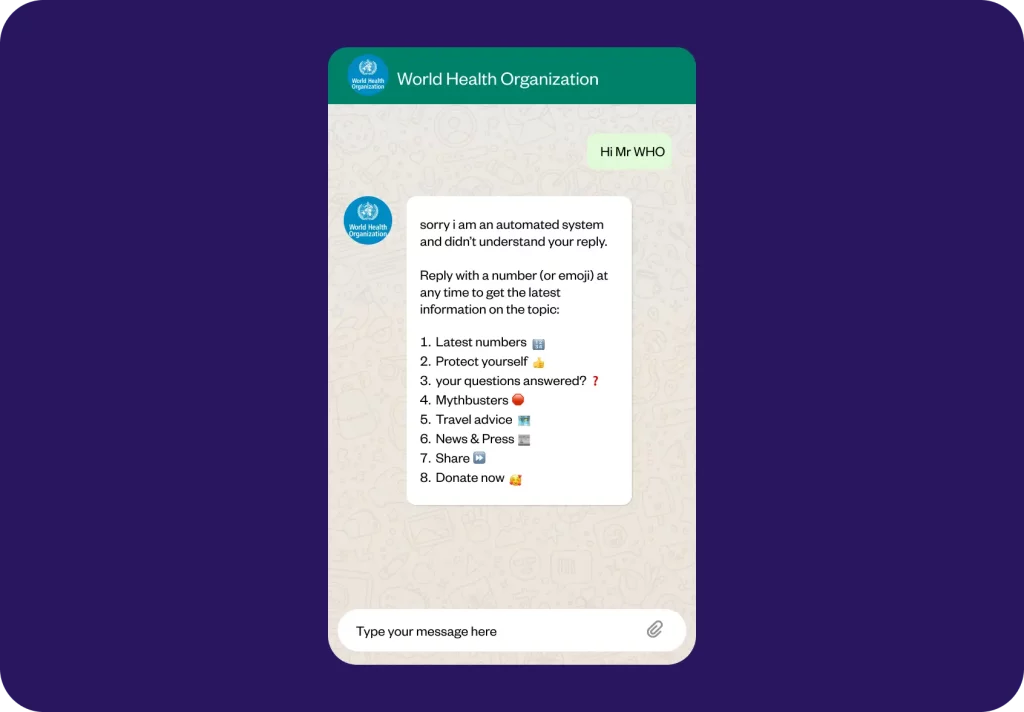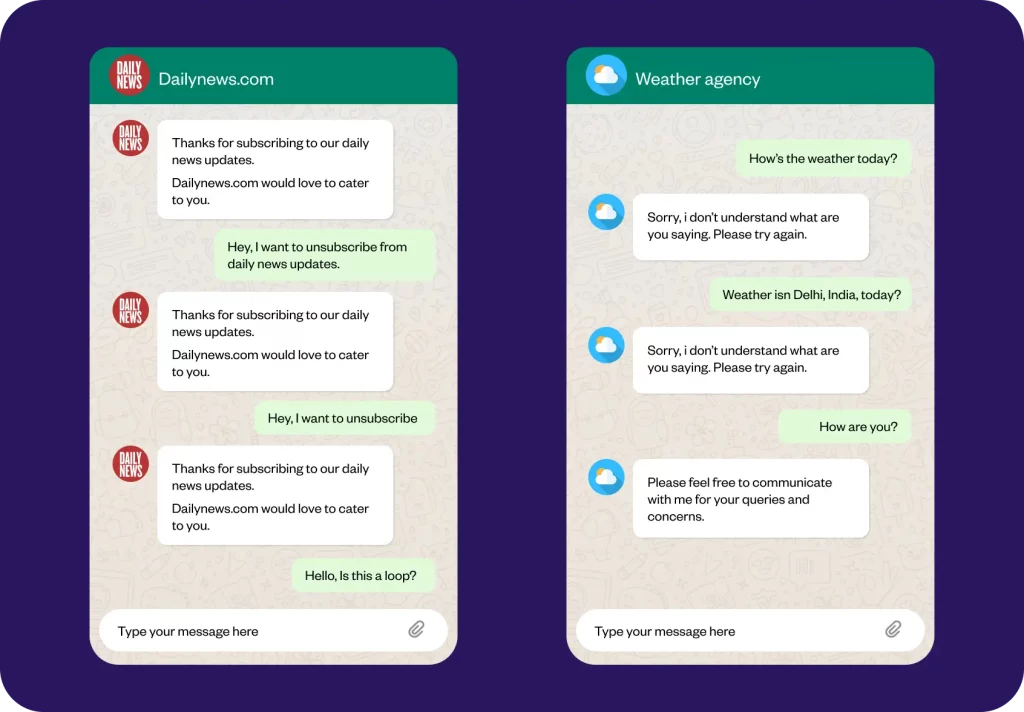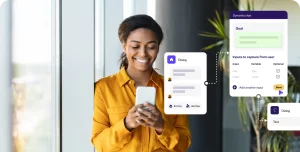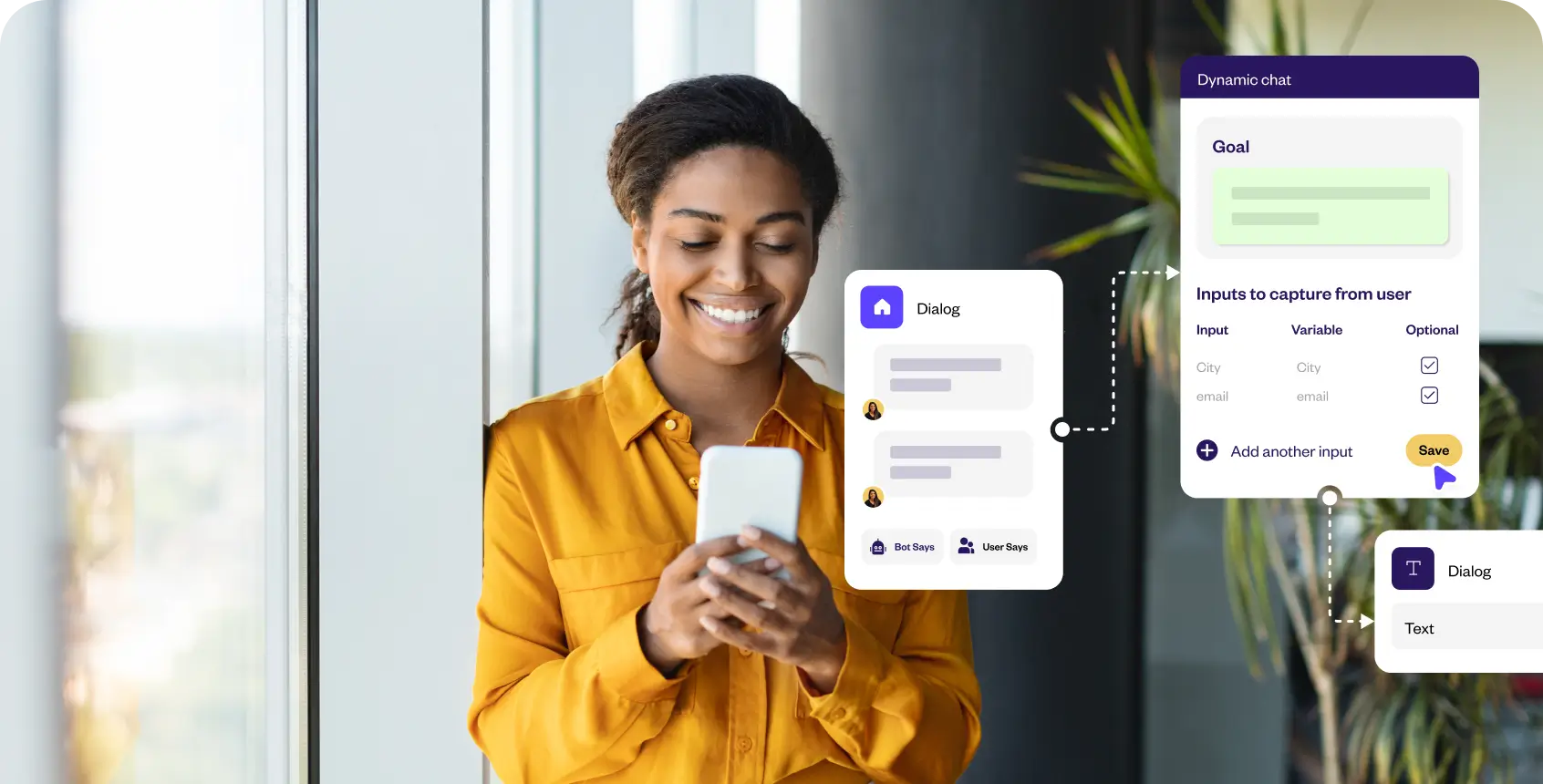The digital customer journey has seen businesses extensively searching for terms like WhatsApp bot, how to make a WhatsApp bot, and chatbot on WhatsApp. This surge isn’t just out of curiosity but a testament to the tool’s transformative power. If you’re a business aiming to enhance customer interactions, streamline queries, and drive growth, this guide is your roadmap. Here, we’ll help you find an answer to ‘how to create a WhatsApp bot’ and walk you through creating an intelligent AI WhatsApp chatbot tailored to your needs.
Imagine the power of immediate, intelligent assistance right at your customers’ fingertips. The WhatsApp chatbot is at the heart of this revolution. It is a fusion of AI and convenience. As businesses strive to be omnipresent and agile, this tool emerges as a game-changer, not just answering but anticipating customer needs.
Yet, creating such a WhatsApp chatbot is more an art than mere technicality. Beyond codes and commands, it’s about crafting experiences, ensuring every interaction is memorable and satisfying. Ready to embark on this transformative journey? Dive in, and let’s build together.
Related must-reads:
- AI chatbots – The complete guide to chatbot solution
- 9 Best chatbot examples for businesses by industry [2024]
- Future of Chatbots: Key Trends to Watch in 2023!
- Enterprise Chatbot – A Guide for Enterprises [2023]
- Benefits of AI Chatbots for Businesses and Customers
What is a WhatsApp chatbot?
A WhatsApp chatbot is the digital equivalent of a diligent assistant who is always available, ensuring your customers never feel unheard. This is not just any chatbot; it’s integrated into one of the most widely used messaging platforms globally.
While chatbots across various platforms automate tasks, a WhatsApp chatbot leverages the familiarity and accessibility of WhatsApp, bridging businesses and customers seamlessly. However, remember that the usual WhatsApp Business App isn’t chatbot-friendly; you’ll need to tap into the WhatsApp Business API to make this magic happen.
WhatsApp chatbot example
Consider a scenario in the healthcare sector. John, a patient with a chronic heart condition, is on multiple medications and follows a strict treatment schedule. He recently experienced some unusual symptoms and is concerned about potential drug interactions. He sends a message to his hospital’s WhatsApp business number, “I started on MedX three days ago and have been feeling dizzy. Could this be an interaction with my other meds?”
The chatbot, having access to John’s medical history and medication details, quickly analyzes the potential interactions of MedX with John’s current prescriptions. It responds, “Hi John, I’ve reviewed your medications. MedX can sometimes interact with MedY, which you’re also taking, and cause dizziness. Please contact your cardiologist as soon as possible. Would you like me to schedule an appointment for you?”
This immediate, comprehensive, and potentially life-saving advice exemplifies the prowess of advanced WhatsApp chatbots in handling intricate situations and offering tailored solutions.

Why use WhatsApp chatbots?
The power of a WhatsApp chatbot goes beyond automation. It’s about enhancing customer relationships and, ultimately, customer experience:
Reach & engagement: With a whopping 2.78 billion users, WhatsApp is not just another app; it’s a digital phenomenon. Businesses can tap into a vast pool of potential customers across age groups by integrating a chatbot.
Preferred mode: Data suggests that a significant chunk, about 61%, of consumers lean towards messaging as their go-to mode of communication. Moreover, the warm reception of business communication on WhatsApp is evident, with nearly 50% of users expressing their preference for it. Why not meet your customers where they’re most comfortable?
Economical & efficient: Gone are the days when you needed massive call centers or hefty CRM tools. With a WhatsApp chatbot, not only do businesses save on operational costs, but they also ensure consistent, round-the-clock customer service.
How does a WhatsApp chatbot work?
At its core, a WhatsApp chatbot works on AI algorithms and natural language processing (NLP). When a message arrives, the chatbot parses it to comprehend the context and intent. Based on this understanding, it crafts a relevant response. If it encounters a complex query or a sentiment it’s not trained for, the chatbot seamlessly transfers the conversation to a human agent. As more conversations happen, the chatbot learns, evolving to provide more accurate responses over time.
Simplifying the process
A WhatsApp chatbot is a dance of logic, triggers, and actions. It’s a system programmed to react, respond, and resolve:
- Trigger: This is the starting point, usually a keyword or phrase, that prompts the chatbot to spring into action.
- Action: Based on the trigger, the chatbot performs a pre-defined action, such as sending a relevant message or pulling up a specific piece of information.
- Condition: This is the chatbot’s decision-making core. Depending on user input or other variables, the bot follows an “if this, then that” logic to ensure the response is relevant.
For instance, if a user messages “Track order,” the bot first checks the order status (condition). If shipped, it sends the tracking details (action); if not, it might provide an estimated shipping date.
WhatsApp message rules: The do’s and the don’ts
Engaging with customers on WhatsApp? Great choice! It’s one of the most popular platforms worldwide. But before you jump in with your chatbot, it’s crucial to understand the messaging rules WhatsApp has in place. These guidelines ensure users don’t get bombarded with unwanted messages. So, let’s simplify these for you.
WhatsApp’s two-way street: Conversations & rules
- User-initiated conversations: This is the most straightforward scenario. A user reaches out to your business, maybe with a query or feedback. Essentially, the ball starts in their court.
- Business-initiated conversations: Here, your business makes the first move, reaching out to a user. It might be for reminders, updates, or promotions.
The 24-hour golden rule
When a user initiates a conversation—be it a simple message, a query, or even clicking a button—a 24-hour response window springs open for the business. This period is your playground:
- Within this window, your business can communicate freely, with no restrictions on the type or number of messages.
- This window is dynamic. Let’s say a user messages you and then, after 10 hours, drops another text. The clock refreshes, and a fresh 24-hour window ensues.
Going beyond the window: The template paradigm
While the 24-hour window offers ample flexibility, what if you wish to reach out after that? Or, more crucially, what if your business wants to initiate a conversation without any prior user interaction?
A quick recap (Summary):
- A conversation can start in two ways: either the user messages you, or you message the user.
- If a user messages you, you’ve got a 24-hour free chat window. And if they message again within this time, the window resets.
- Want to chat after 24 hours? Stick to the approved WhatsApp Message Templates.
Remember, these rules aren’t there to make life difficult. They’re designed to ensure everyone has a good experience on the platform. By following them, you’ll be on the right path to building strong, spam-free relationships with your customers on WhatsApp.
WhatsApp message templates: A guide for modern businesses
WhatsApp message templates are not mere texts that businesses shoot out but crafted interactions that fit every customer’s unique needs. These templates are pre-defined messages that companies can deploy for various interactions.
A WhatsApp message template is a concoction of pre-crafted content, which businesses can tailor using specific variables like a customer’s name, order details, or any context-driven information. This ability to personalize while staying consistent makes templates invaluable. But it’s not just about firing a one-size-fits-all message; blending standardization with personalization makes them tick.
Modern AI WhatsApp chatbots elevate the game. While traditional message templates have their charm, today’s chatbots go the extra mile in providing intelligent, context-aware interactions. Here’s how:
Text templates:
They form the bedrock of any messaging system. They are often used for confirmations, reminders, or general notifications.
Example:
“Hello, [Customer Name]!
Your appointment with [Doctor Name] at [Clinic Name] is confirmed for [Date and Time].
Thank you for choosing us!”
Templates with attachments:
Often, a simple text won’t cut it. In scenarios requiring detailed information—be it a product brochure, an invoice, or an event poster—these templates come to the rescue.
Example:
“Greetings [Customer Name]!
Based on our discussion, here’s the proposal for our services.
We look forward to your feedback.”
[Attached: Service Proposal PDF]
Call to Action (CTA) templates:
Interactive and actionable. These templates let businesses embed buttons, pushing users towards specific actions—be it tracking an order, visiting a product page, or joining a live webinar.
Example:
“Good news, [Customer Name]!
Your package with order ID [Order Number] is en route.
Want to see where it’s at? Just tap below!”
[Track Package Button]
Promotional templates:
AI-driven chatbots thrive on data. And, with the correct insights, promotional templates become highly targeted. They’re not just generic sales pitches but tailored recommendations.
Example:
“Hey [Customer Name]!
We noticed you love our [Product Category]. Guess what?
We have an exclusive sale, just for enthusiasts like you. Dive in!”
[Exclusive Sale Button]
Now, while we’re all for personalization, WhatsApp ensures no one feels overwhelmed. Every template passes through the watchful eyes of WhatsApp guardians, ensuring you and I, the users, get messages that matter, not random noise. If businesses play too fast and loose, WhatsApp might give them a gentle tap, asking them to refine their approach. It’s all about keeping the conversation authentic and relevant.
Top 7 benefits of using WhatsApp chatbots
WhatsApp chatbots stand out as a beacon of transformative change for businesses. But why should your enterprise invest in a WhatsApp chatbot? Here’s a breakdown of the multifaceted advantages:
1. Offers 24/7 customer support
Unlike traditional customer service avenues, WhatsApp chatbots don’t clock out. They’re at your customers’ beck and call, 24/7. It ensures that your clientele always has a touchpoint irrespective of time zones or work hours, making your brand consistently accessible.
2. Enhanced customer interactions
With minimal wait times and speedy responses, chatbots on WhatsApp deliver a customer service experience that’s smooth and efficient. They quickly address basic queries, and when things get complex, they seamlessly shift the conversation to human specialists. This blend of AI and human touch ensures your customers always feel attended to.
3. Easy accessibility
WhatsApp isn’t just another app—it’s a digital space that billions already use. Its intuitive interface ensures that interacting with your business becomes second nature for your clients, eliminating the learning curve often associated with new digital tools.
4. Better engagement
WhatsApp chatbots don’t just respond—they engage. They keep the conversation flowing, making customer interactions feel less transactional and more conversational. This dynamic dialogue deepens the bond between businesses and their clientele.
5. Better marketing opportunities
While emails might go unread and social media posts might get buried, a message on WhatsApp is hard to ignore. Whether launching a new product, announcing a sale, or sharing an update, WhatsApp chatbots ensure your message lands front and center. Their ability to automate routine marketing tasks frees up time and resources.
6. WhatsApp chatbot deliver personalized experiences
Today’s customers crave personalization, and AI-driven WhatsApp chatbots deliver precisely that. By remembering user preferences, purchase histories, and even past interactions, chatbots curate experiences that feel custom-made. Whether recommending a product or sharing a curated offer, these chatbots make your clientele feel seen and valued.
7. Trustworthy & secure
WhatsApp stands tall with its commitment to user security in a world rife with digital threats. With features like end-to-end encryption and two-factor authentication, WhatsApp chatbots ensure that your customers’ data remains protected. Besides safeguarding sensitive information, it also fortifies your brand’s reputation.
WhatsApp chatbot success stories powered by Yellow.ai
Brands worldwide are realizing the potential of chatbots in enhancing customer experiences, especially on widely-used platforms like WhatsApp. These chatbots bolster efficiency and also offer personalized interactions.
Here are three remarkable brand journeys enhanced by chatbots and powered by Yellow.ai.
1. Sayurbox’s rise in satisfaction scores
A flourishing brand, Sayurbox grappled with a deluge of inbound requests and faced challenges with real-time agent availability. Their answer was an Omnichannel Virtual Assistant devised by Yellow.ai. This intelligent entity was not just confined to WhatsApp but extended its presence to web interfaces. The results were staggering.
Sayurbox recorded a 45% surge in Customer Satisfaction (CSAT) scores, underscoring the remarkable benefits of well-integrated WhatsApp chatbots in driving customer happiness.
How to create a chatbot on WhatsApp with best practices? A step-by-step guide
Navigating chatbots, especially on platforms as popular as WhatsApp, can be overwhelming. But with a clear roadmap and some expert insights, businesses can harness this tool effectively. Our comprehensive guide to creating a WhatsApp chatbot ensures you’re primed for success.
Step 1. Define your Chatbot’s purpose: The why
Before getting into the technicalities, ask the big question: Why do you need a chatbot? Are you aiming to send timely reminders, invoices, or shipment details? Perhaps you envision it as a digital concierge for customer queries? Defining its core purpose will set clear objectives and ensure that every subsequent step aligns with this vision.

Step 2. Access the WhatsApp API: Your digital key
Accessing the WhatsApp Business API is paramount to integrating a chatbot with WhatsApp. While certain providers, like Yellow.ai, offer seamless integration, you must familiarize yourself with the process. Engaging directly with trusted API providers can simplify this crucial phase.
Step 3. Find a partner with a chatbot: Strength in collaboration
While large-scale corporations might possess the resources to create their chatbot tapestry, medium-scale businesses can benefit immensely from teaming up with experienced chatbot providers. This partnership ensures your chatbot operates efficiently and offers a harmonized experience across multiple channels.
Step 4. Build your chatbot persona: Giving it a soul
Behind every chatbot lies a persona – a character that embodies your brand and connects with users. Whether witty, professional, or empathetic, this persona dictates how your chatbot communicates. Fleshing out this character ensures a consistent, relatable, and engaging user interaction.
Step 5. Build your WhatsApp chatbot: The blueprint in action
While many WhatsApp chatbots operate on predefined rules, responding to specific keywords and infusing them with AI can significantly amplify their efficacy. This integration enables them to field frequent queries easily and ensures a dynamic conversation flow. Embedding response templates and curated scripts can further streamline this process.
Step 6. Test it for various use cases: Test, refine, repeat
Deploying your chatbot without rigorous testing is like setting sail in uncharted waters. Engage in extensive trial runs, simulating real-world interactions. Invite colleagues or beta testers to interact with your chatbot. Their fresh perspective might spotlight issues that slipped past you. Address these glitches, refine the bot, and gear up for a smooth launch.
Step 7. Set it live and promote it: Let the world know
Once your chatbot is operational, it’s time to turn the spotlight on it. Integrate your chatbot’s WhatsApp number with your social media handles for seamless customer transitions. As the interactions flow in, continually monitor them. Analyzing conversation drop-offs, feedback, and user queries can offer invaluable insights, driving further refinement and ensuring an ever-evolving chatbot experience.
Following these steps and keeping the end user in mind can help businesses sculpt a chatbot experience that meets and exceeds customer expectations.
The best WhatsApp chatbot platform for your money
In the vast world of chatbot platforms, Yellow.ai has distinguished itself as one of the frontrunners, particularly for businesses keen to make an impression on WhatsApp. Here is why Yellow.ai stands out.
Custom conversations: Yellow.ai crafts genuine conversations that resonate with your brand’s tone. By facilitating customized interactions, businesses can genuinely connect with their audience.
User-friendly design: Yellow.ai gets it—not everyone is a coding whiz. And that’s okay. Their intuitive, no-code-builder ensures that even those new to the tech scene can whip up a chatbot quickly.
Get started quickly: You can hit the ground running with various ready-made templates. Instead of starting from scratch, businesses can get their chatbots up and active pronto.
The best of both worlds: Merging AI’s efficiency with human insight with their NLP technology, Yellow.ai ensures that interactions are smart and personable.
Amp up your marketing: It’s not just about answering questions. Yellow.ai offers tools to push marketing campaigns, helping businesses connect with potential customers.
Stay in the know: With analytics and insights, you can see how your chatbot is performing, allowing for tweaks and refinements along the way.
Plug and play: Yellow.ai plays well with others. Whether it’s integrating with other apps or systems, the platform ensures your chatbot fits seamlessly into your existing operations without changing your established tech infrastructure.
Want to learn more? If Yellow.ai sounds like the chatbot solution you’ve been looking for, why wait? Book a demo with us and see how it can transform your business.
FAQs about WhatsApp chatbot integration
We are sure you might have heard a lot of misinformation about the topic and might have many questions. We will try to answer the most common questions that we have received since we became business solution providers.
1. Does Yellow.ai help in the WhatsApp Business API application process?
As soon as you apply for WhatsApp business API with Yellow.ai, our team will connect with you and understand your requirements. Post that we will be a part of your application process that may take up to 7 working days.
2. Can we create conversational ads on WhatsApp using API?
Promotional templates are not allowed by WhatsApp. Alternatively, you can add a CTA button to your ad on Facebook, Instagram and other platforms that land in your WhatsApp chat window.
3. How does Yellow.ai help with the WhatsApp Business API application process?
In partnership with WhatsApp, Yellow.ai ensures zero wait time for getting businesses verified. With our conversational expertise, we can help your business deliver smart conversations as soon as you are ready with the WhatsApp chatbot.
4. How long does it take for WhatsApp Business API to start functioning?
It takes around 2-3 weeks for the WhatsApp Business API to start functioning but it can vary depending on the use cases and API integrations opted.
5. Can I start designing my bot before my WhatsApp API access is approved?
Yellow.ai allows you to build a no-code WhatsApp chatbot on our bot studio and test it before your API application gets approved.
6. Do you provide WhatsApp bot tutorials?
Yes, Yellow.ai provides a demo video explaining all the use cases of the bot, as well as our support team is available 24/7 for any clarification.
7. Does Yellow.ai provide artificial intelligence with WhatsApp Chatbots?
Yellow.ai gives WhatsApp chatbot service embedded with AI NLP-driven technology using the cognitive platform.
8. Can a WhatsApp chatbot be created without coding?
Yes, a simple FAQ bot can be created on WhatsApp without any code. Although, if the use cases of the chatbot are complex, you need to have a hard-coded WhatsApp chatbot.
9. Is it possible to create FAQs for the WhatsApp chatbot for faster navigation?
Yes, a simple FAQ Whatsapp chatbot can be created in no time, as no coding is required. With the help of a cognitive platform, you can have your WhatsApp Business API up and running within 24hours.
10. What are the metrics that can be tracked for the WhatsApp chatbot?
The following analytics are provided for WhatsApp Business API:
- Message Delivery Reports: Information when the message was delivered to WhatsApp.
- Message Seen Reports: Information when the message was read in the WhatsApp Application.
- Number of Users: Total number of users actively using the chatbot.
- Total Messages: Total number of messages received.
- Average Session Time: Interaction time of the user with the chatbot
- Custom Analytics: If your enterprise needs custom analytics, Yellow.ai can provide a custom analytics dashboard.
11. How can we use QR codes to invite customers to our WhatsApp chatbot?
Enterprises can use Whatsapp QR codes to invite their customers over WhatsApp. It can be displayed on your website, banners, digital ads, Facebook page, newspaper, product, basically, anywhere you can imagine.
12. What type of content can be sent using WhatsApp Chatbot?
You can send and receive text messages, audio content, URL, location information, images, videos, stickers as well as any document in any format. You can even send and receive emoticons.
13. Can the enterprise CRM be integrated with the WhatsApp chatbot?
Enterprises can connect their CRMs like salesforce, Freshsales, and billing and invoicing software with the WhatsApp chatbot on the Yellow.ai platform easily.
14. What does it mean to be a WhatsApp partner?
WhatsApp partners or WhatsApp business partners are companies that can help other companies get their WhatsApp verified within no time. Yellow.ai ensures zero wait time so that businesses can start with conversational AI from the first day.
15. Does WhatsApp chatbot support multiple languages?
Yes, the WhatsApp chatbot is multilingual and supports 10 languages currently
The final word
When it comes to digital communication, finding the right tools can make all the difference. WhatsApp chatbots, especially those powered by platforms like Yellow.ai, are proving to be invaluable allies for businesses. Making interactions smoother, personal, and efficient reshapes how we think about customer engagement. Now might be a perfect time if you haven’t explored this avenue yet.





























